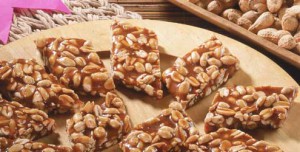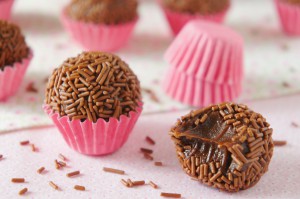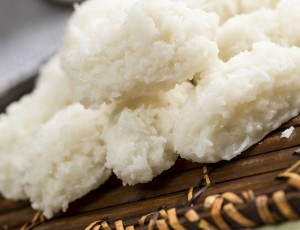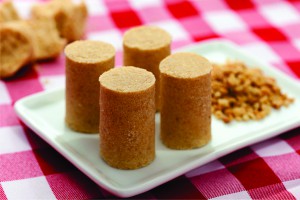Brazilian Candy Posted by carol on Mar 4, 2016 in Brazilian Profile, Culture, Customs, Entertainment
A country’s cuisine is an essential part of its culture. And this goes beyond main dishes: sobremesas (desserts) are also relevant for understanding a nation’s history and habits and, for some, a melhor parte (the best part). So esqueça (forget) about your diet for a while prepare-se (get ready) to indulge in the delicious world of Brazilian sweet treats.
It is no wonder that the world’s largest producer of sugarcane would have a sweet tooth: Brazilians really enjoy their candy. So today’s post will falar sobre (talk about) quatro (four) popular confectionery items that can satisfy anyone’s sugar craving!
Brigadeiro
An all-time favorite, the brigadeiro is a delicacy made from condensed milk, powdered chocolate and manteiga (butter). It consists of tiny balls, with an added layer of sprinkles for that extra touch (though many Brazilians can’t resist the urge of comer (eating) it straight from the pot while watching a movie). Present in most celebrations, de aniversários a casamentos (from birthdays to weddings), it’s not a festa (party) if brigadeiro is not there.
Its origins, though unclear, seem to be directly connected to our history. The treat is said to be named after a brigadier who was running for president in the ‘40s. Women would make the brigadeiro and sell it on the streets to promote the candidate and support his campaign. Since it was wartime, it was difficult to get ahold of (leite e açúcar) milk and sugar, that’s why condensed milk became its primary ingredient.
Cocada
This coconut-based doce (candy) was brought to Brazil by the African slaves in colonial times and it is particularly traditional in the northeast, specially Bahia.The receitas (recipes) vary greatly and many different kinds can be found all throughout the country. Some just add água (water) and sugar to shredded coconut in a pot over low heat, while others include condensed milk or brown sugar for that special flavor. Even though many countries, like Venezuela and Angola, have their own version of this treat, the cocada stands as a national icon, so regardless of which you pick, this typical sweet will still carry a sentimental value, besides being unmistakably delicious.
Paçoca
A classic, also endearingly named “paçoquinha”, the paçoca é vendida (is sold) everywhere, and it ranks among the favorite sweets Brazilians like to consume. This candy is made chiefly from ground peanuts, sugar, salt, and sometimes cassava flour, giving it an unique taste and soft texture. It is more commonly encontrada (found) manufactured industrially rather than caseira (homemade), but you can still find recipes online to make your own. The word “paçoca” comes from an indigenous word that means to crush, to crumble, alluding to its preparation. Oh, but cuidado (beware)! In the northeast, “paçoca” is a savory dish with sun-dried meat (also very tempting, but not sweet at all).
Pé-de-moleque
Literally translated as “boy’s foot”, the pé-de-moleque is similar to a nut brittle. The doce (candy) is made from amendoins (peanuts) stirred into caramelized sugar, which is then laid out on a flat surface for cooling.
Its name dates back from colonial times, as an allusion to the paved streets, since both have the same irregular appearance. The foot part is due to the uneven shape of the pedras (stones) – because crianças (kids) at the time were supposed to stomp them so as to level them out -though as these things go, there are many other hypothesis to explain its unusual name. Still, this crystallized treat has been around for centuries, and it remains a treasured dessert.

Já provou algum desses? (Ever tried any of these?) Você não vai resistir (You won’t be able to resist them)

Build vocabulary, practice pronunciation, and more with Transparent Language Online. Available anytime, anywhere, on any device.







Comments:
Carlos R, Barron:
obrigado por la informacion eu aprendo algo.
Sorry I use maybe some word in Spanish.
Carlos R. Barron mora no Milaukee, Wisconsin